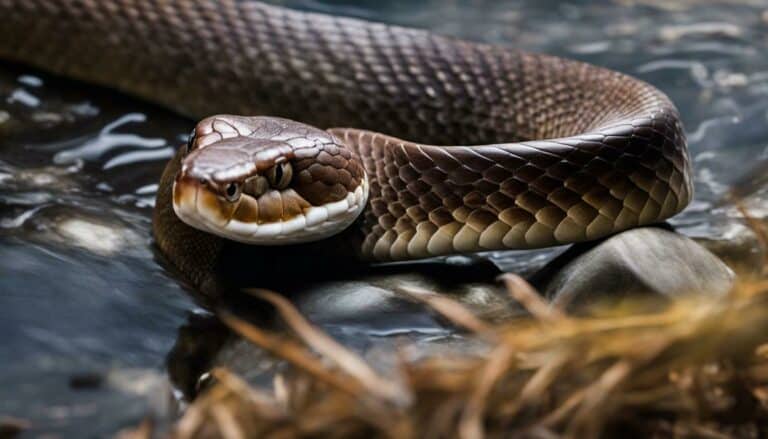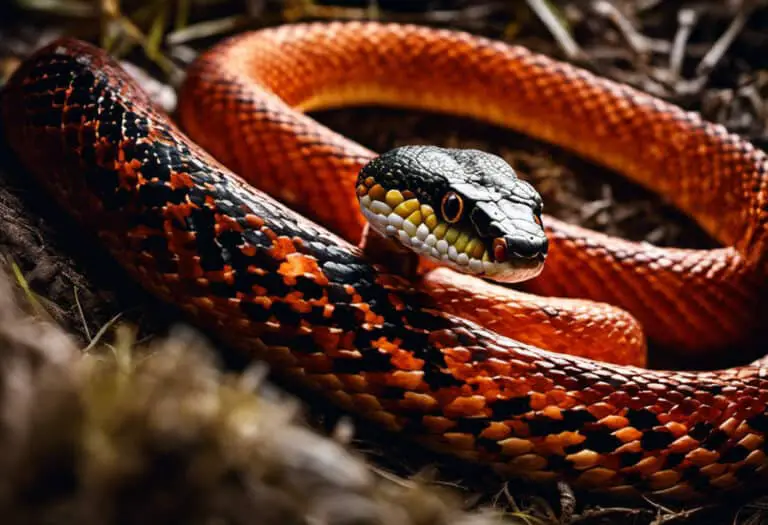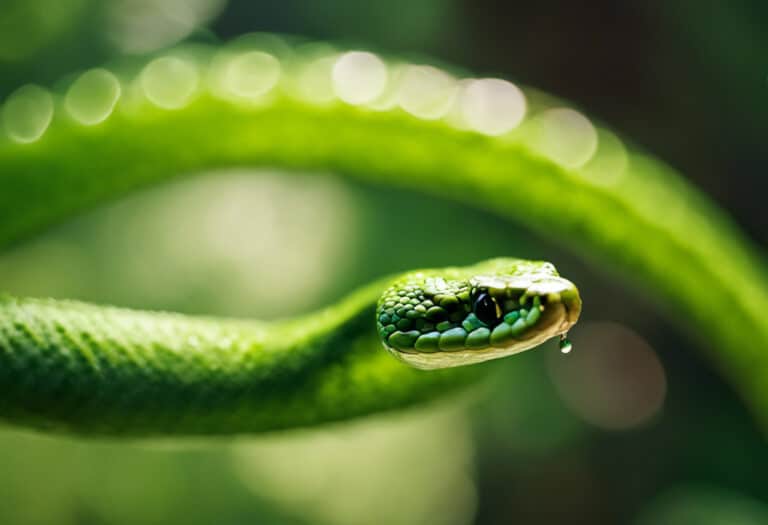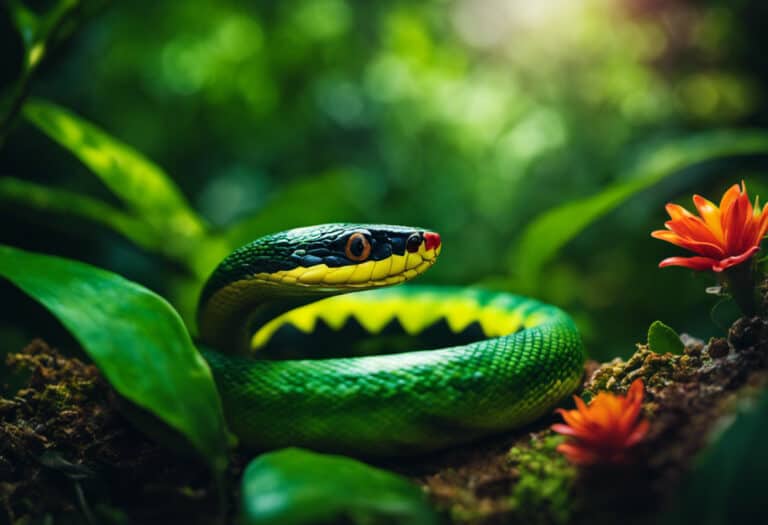What Do Pine Snakes Eat?
Do you ever wonder what sustains the magnificent northern pine snake? Join us as we delve into its fascinating diet.
With its distinctive head shape resembling a turtle, the pine snake has unique adaptations that help it thrive. Its pointed snout and enlarged rostral scale enable it to efficiently dig and spend most of its time underground.
This snake feeds on a variety of prey, including rodents, small mammals, birds, bird eggs, lizards, and insects. Discover the eating habits and hunting strategies of this vital creature.
Key Takeaways
- The northern pine snake feeds on rodents, small mammals, birds, and bird eggs.
- Young snakes also consume small mammals, lizards, and insects.
- The snake’s diet consists of a variety of prey items found in its native habitat.
- Pine snakes play an important role in controlling rodent populations in their ecosystem.
Rodents
The northern pine snake, in its natural habitat, relies on rodents as a significant part of its diet.
While it may consume other prey, such as small mammals, birds, and bird eggs, its preference for rodents is evident.
When it comes to bird prey preferences, the northern pine snake doesn’t specifically target birds as a primary food source.
However, if the opportunity arises, it won’t hesitate to consume birds or their eggs.
In terms of hunting techniques used, the northern pine snake is an ambush predator. It relies on its excellent camouflage and patience to lie in wait for unsuspecting prey to pass by.
Once within striking distance, the snake will quickly lunge forward, capturing its prey with its sharp teeth and powerful constriction.
Overall, the northern pine snake’s ability to adapt its diet and hunting techniques demonstrates its freedom to exploit different food sources in its environment.
Small Mammals
Small mammals play a crucial role in the diet of the northern pine snake. They serve as a primary source of prey for this species, contributing to its survival and overall health.
Additionally, the presence of small mammals in the snake’s habitat can also impact the local ecosystem by influencing population dynamics and energy flow within the food web.
Rodents as Prey
When it comes to food, you’ll find that pine snakes have a diverse diet that includes rodents.
These snakes play an important role in the ecosystem by controlling rodent populations. Rodents, such as mice and rats, can cause significant damage to crops and spread diseases. By preying on them, pine snakes help maintain a balance in the ecosystem.
Additionally, pine snakes also consume bird eggs, which can have a significant impact on bird populations. Bird predation by pine snakes can lead to a decrease in bird numbers, affecting the overall biodiversity of an area.
However, it’s important to note that pine snakes aren’t solely dependent on rodents and birds for their diet. They also consume small mammals, such as rabbits and squirrels, further contributing to the balance of the ecosystem.
Bird Predation Possibilities
You’ll be interested to know that bird predation plays a significant role in the diet of the northern pine snake. While the snake primarily feeds on rodents, small mammals, and bird eggs, it also targets birds as a food source.
This is particularly important to consider in light of the current bird population decline and ongoing bird conservation efforts. The decline in bird populations is a matter of concern, as it disrupts the balance of ecosystems and affects biodiversity.
Understanding the role of predators like the northern pine snake in bird predation is crucial for conservation efforts. By studying the feeding habits and ecological interactions of the snake, scientists can gain insights into the complex dynamics of predator-prey relationships and develop strategies to mitigate the impact of predation on bird populations.
Impact on Ecosystem
Understanding the impact of the northern pine snake on the ecosystem is essential for assessing its role in maintaining biodiversity and ecological balance.
This snake plays a crucial role in the food chain, as it preys on rodents, small mammals, birds, and bird eggs. By controlling the population of these prey species, the pine snake helps to prevent overgrazing and competition for resources.
Additionally, as the snake burrows underground, it disturbs the soil, promoting aeration and nutrient cycling. This impact on the soil can enhance the growth and diversity of plant species.
Furthermore, the pine snake’s presence in the ecosystem can influence the behavior of other organisms, such as avoiding areas where the snake is known to reside.
Overall, the northern pine snake contributes to the health and balance of the ecosystem by regulating prey populations, improving soil conditions, and influencing the behavior of other species.
Birds
Birds are an important part of the northern pine snake’s diet, alongside small mammals and their eggs. The snake has adapted hunting techniques to catch birds, such as ambushing them from trees or striking at them while they’re on the ground.
The presence of birds in the snake’s diet can have an impact on bird populations, especially if the snake’s population increases or if certain bird species become targeted more frequently.
Bird Prey Preferences
When it comes to food preferences, pine snakes have been known to consume a variety of prey, including birds and their eggs. Pine snakes are opportunistic hunters and will take advantage of any available food source.
Their diet often includes small birds and their eggs, making bird nests and migration patterns important factors in their foraging behavior. Pine snakes have been observed preying on birds that nest on the ground or in low shrubs, such as sparrows and thrushes. They may also target birds during their migration, when they’re weakened and vulnerable.
Impact on Bird Populations
You may be interested to know that the impact of pine snakes on bird populations is a complex issue that requires further research and investigation.
Bird population decline can be influenced by various factors, including predation by pine snakes. These snakes are known to feed on birds and their eggs, which can have a significant impact on nesting behavior and overall population numbers.
Pine snakes are skilled predators and can locate bird nests, especially those located on the ground or in low-lying shrubs. They’ve been observed to consume both adult birds and their eggs, which can lead to reduced breeding success and population decline.
However, it’s important to note that the exact extent of their impact on bird populations isn’t yet fully understood and requires more in-depth studies to determine the overall implications.
Hunting Techniques Used?
The hunting behavior of the northern pine snake is characterized by its effective prey capture techniques. When hunting, the snake relies on its keen sense of smell to locate potential prey.
Once it detects its target, the snake uses a combination of stealth and ambush to capture its prey. It moves slowly and silently through the undergrowth, blending in with its surroundings, and strikes with lightning speed when the moment is right.
Prey capture techniques employed by the northern pine snake include constriction and swallowing whole. After seizing its prey with its powerful jaws, the snake coils its body around the prey, applying pressure to restrict its breathing and blood flow. This suffocates the prey, rendering it immobile.
Once the prey is subdued, the snake opens its jaws wide and slowly ingests the prey, swallowing it whole.
These hunting techniques allow the northern pine snake to efficiently secure its food source and ensure its survival in its natural habitat.
Bird Eggs
Bird eggs are a preferred food source for the northern pine snake. They have a significant impact on reptiles due to their nesting habits. Here is a visual representation of the impact:
- Availability: Bird eggs are abundant and easily accessible in various habitats where the northern pine snake resides.
- Nutritional Value: Bird eggs provide a rich source of nutrients, including proteins and fats, which are essential for the snake’s growth and energy requirements.
- Hunting Strategy: The snake locates bird nests by scent or visual cues and consumes the eggs whole. It has a specialized jaw structure that allows it to swallow large prey items.
The consumption of bird eggs by the northern pine snake demonstrates its adaptability as a predator and highlights its role in maintaining ecological balance.
Lizards
Lizards are skilled predators that have a significant impact on lizard populations. As a predator, lizards play a crucial role in maintaining the balance of ecosystems. They’re agile and stealthy, using their sharp claws and jaws to capture their prey.
Lizards are opportunistic hunters and have a varied diet, which includes insects, small mammals, birds, and even other lizards. Their presence in an ecosystem helps control the population of their prey species, preventing overpopulation and its negative consequences.
However, the predatory nature of lizards can also pose a threat to lizard populations. When lizards prey on other lizard species, it can lead to a decline in their numbers. This can disrupt the delicate ecological balance and potentially result in the loss of certain lizard species.
Therefore, understanding the impact of lizards as predators is crucial for conservation efforts and maintaining biodiversity.
Insects
If you see a northern pine snake, it may be hunting insects for its meal. These snakes are opportunistic predators, utilizing various hunting techniques to catch their prey. Here are three key techniques they employ:
- Ambush hunting: The northern pine snake will patiently wait in a concealed location, such as a tree stump or leaf litter, for unsuspecting insects to pass by. Once within striking distance, it will swiftly capture its prey with a quick strike and swallow it whole.
- Pursuit hunting: In some cases, the snake may actively chase after flying insects, such as moths or butterflies. It relies on its speed and agility to catch these fast-moving prey items, striking them out of the air and consuming them on the ground.
- Nest predation: Birds often build nests in trees or on the ground, providing an ideal opportunity for the northern pine snake. It will climb trees or dig into the ground to reach the nests, where it can feed on both the eggs and the nestlings.
With these versatile hunting techniques, the northern pine snake is able to exploit a wide range of insect prey, ensuring its survival in its natural habitat.
Frequently Asked Questions
How Often Do Pine Snakes Need to Eat?
Pine snakes can go without eating for long periods, as they have the ability to store fat reserves. However, they need to eat regularly to maintain their energy levels. They don’t have any specific dietary restrictions.
Are Pine Snakes Able to Eat Larger Prey, Such as Rabbits or Squirrels?
Pine snakes, including the northern pine snake, have a varied diet that includes rodents, small mammals, birds, and bird eggs. However, they are not typically known to eat larger mammals like rabbits or squirrels.
Do Pine Snakes Have Any Specific Hunting Techniques?
Pine snakes have specific hunting techniques. They use their keen sense of smell to locate prey. Once found, they ambush their prey by striking quickly and constricting it until it suffocates. This allows them to eat a variety of small mammals, birds, and eggs.
Are There Any Specific Types of Birds That Pine Snakes Prefer to Eat?
Pine snakes have a varied diet, including rodents, small mammals, birds, and bird eggs. They also consume small mammals, lizards, and insects. They catch their prey by ambushing or actively searching for it.
How Do Pine Snakes Locate Their Prey?
Pine snakes locate their prey through a combination of visual and olfactory cues. With their keen eyesight, they scan their surroundings for movement. They also rely on their highly developed sense of smell to detect the scent trails left by potential prey.
Conclusion
In conclusion, the northern pine snake’s diet is incredibly diverse and impressive. From devouring rodents and small mammals to feasting on birds, bird eggs, lizards, and even insects, this snake has an appetite that knows no bounds.
Its unique adaptations and hunting strategies allow it to thrive in its natural habitat, playing a vital role in maintaining the delicate balance of the ecosystem.
Truly, the northern pine snake is a magnificent creature with an insatiable hunger for survival.






